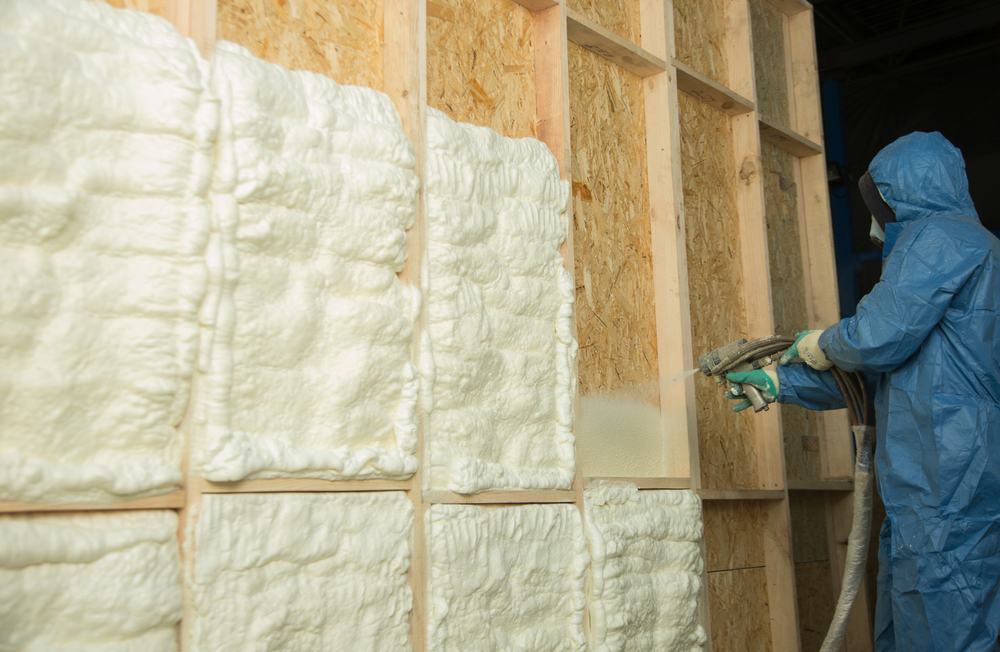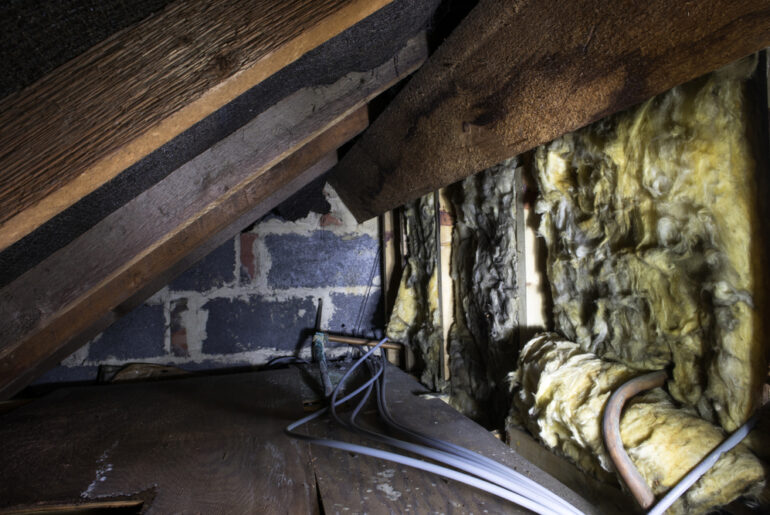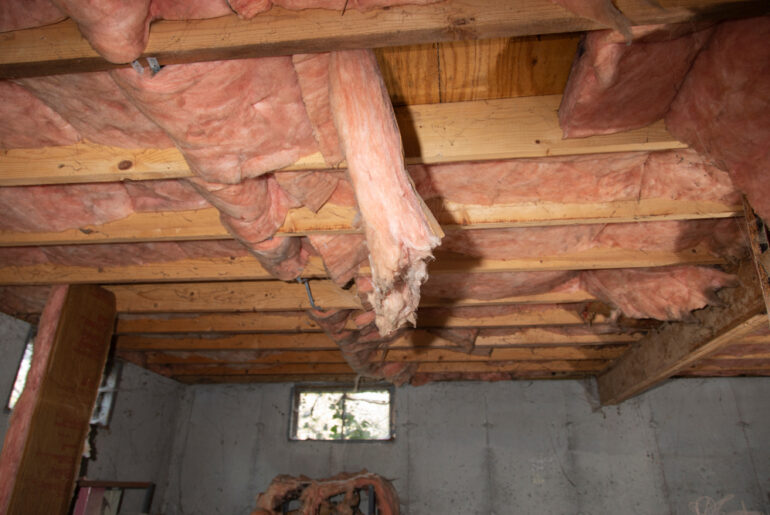Expanding spray foam is a fantastic insulation material, but it requires some level of protection to be long lasting. Spray foam is a common insulation material in modern homes because it works great, solves common leak problems, and lasts for decades.
However, most spray foam formulations are not designed to ensure the UV radiation from the sun or remain submerged in water. As a result, most spray foams require some form of covering, like drywall, plastic, wood, and paint.
If spray foam insulation is left to the elements, eventually the sun will bake out the flexibility of the material and it will disintegrate. Adding a covering protects the foam and usually improves the appearance.
Here we will discuss the five most common ways to effectively cover your spray foam insulation and offer a few suggestions to make the project more successful.
Why Should Spray Foam Be Covered?
Spray foam should be covered to improve the appearance, maintain the condition, and ensure durability of the foam.
Appearance
Spray foam will expand into the space it occupies, so if it is visible, the foam will have a lumpy, uneven appearance. Covering the foam with drywall, paneling, or other smooth surface will retain the effectiveness of the foam, but greatly improve the look.
Condition
Wear and tear, as well as UV radiation will degrade spray foam if the foam is left exposed for long periods of time. Covering the foam will protect it from physical damage as well as UV damage, while hiding it from view.
Durability
Spray foam is designed to maintain its shape and R value for nearly the entire lifespan of the product. Spray foam does not settle, detach, or compact, unlike its counterparts fiberglass and cellulose. Left uncovered however, spray foam will not reach its maximum lifespan.
Should Any Spray Foam Be Covered?
To be clear, there are spray foam materials that will not necessarily require some form of protection, although a covering is still added protection. These foams are typically industrial versions for specific applications, so appearance is not a primary concern.
Whether you are using closed cell or open cell spray foam, both options can be either covered or left exposed depending on circumstances.
When Do You Not Need to Cover Spray Foam?
Most spray foam manufacturers do not require the foam be protected if the area is a storage space entirely indoors. Examples would be an attic, chase, crawlspace, and other stand alone structures used for storage.
These areas are considered a dead load, meaning people won’t be living there. These areas are protected from the elements, but they are not designed to be occupied by humans.
To be clear, spray foam (or any insulation) is not required to be covered in these areas, but it is recommended. Here is a list of common locations spray foam would not require covering, but it is still recommended:
Attics
Spray foam applied in attics is perfectly at home in a well ventilated attic. Spray foam does a great job of closing the tiny openings that allow pests to enter and requires no fasteners. In an attic, spray foam does not require covering, but if you ever plan to convert it to living space, insulation will be required.
Chases
A chase is a channel or pathway often built into homes for future expansion. An example of a chase would be a narrow shaft that extends from the first floor to any rooms above. A chase is usually invisible to the casual observer and will be hidden behind the walls.
Crawlspaces
Crawlspaces will not require the covering of spray foam as long as the home has a permanent, enclosed foundation. However, be aware that the space underneath mobile homes is not a crawlspace unless it is enclosed. If the mobile home is being supported by a temporary foundation, the spray foam will require a covering.
External Storage Buildings
Spray foam used in external storage buildings does not require covering. However, if the building is also used as a workshop where sparks and other sources of flame may be present, the foam must be covered.
Dog Houses
Dog houses and other animal shelters are often completely uninsulated. However, using spray foam to stop drafts will make the shelter more comfortable. Animals dislike the taste of spray foam insulation, so dogs won’t usually chew on it.
Well Houses
For those homeowners using a well, spray foam insulation is commonly used to reduce freezing of the pump and pressure tanks in winter. In these instances, covering spray foam is not required.
However, if you supply supplemental heat to your well house in the form of a heat bulb or heat tape, painting the foam with heat resistant spray foam is a great idea, but make sure to use primer or water based paint.
Well houses are usually self enclosed and detached from the home, so an overheating event may go unnoticed. Covering the spray foam adds peace of mind just in case a spark occurs unexpectedly.
Can I Cover Spray Foam Myself (DIY)?
If you are handy with common household tools, you can probably cover spray foam yourself. Do-it-yourselfers will likely find the plastic and painting methods easiest, but drywall and wood paneling are certainly within the skills of a do-it-yourselfer.
Spray Foam Cover Options
1. Drywall
In most spray foam installations, the foam is sprayed between the studs against the wall sheathing. Most professionals use tape or a scraper to remove any foam on the studs that escapes the wall void before installing the drywall.
From an installation prospective, there is no difference between installing drywall over a wall with spray foam and installing it over batts. The wall may need a vapor barrier, but that will not affect the installation process of the drywall.
Drywall will likely be one of the most expensive options due to the finishing. However, if a smooth, paintable, durable wall is the goal, drywall is a great option. The only downside to drywall is the additional labor needed compared to simpler methods like painting.
2. Wood Paneling
Wood paneling, like T1-11 or tongue and groove paneling can also be used to cover spray foam insulation. The process is the same as for drywall, but you’ll want to install a 6mm plastic vapor barrier over the wall first to help prevent warps and twists in the paneling.
Wood paneling makes a great cover for spray foam because it is so tough. Thick, laminated panels, like T1-11 are commonplace because they provide a semi-smooth surface, install quickly, and will be the most durable option on this list.
Wood paneling will likely be the most expensive option, but will likely also last the longest. Drywall is great for covering spray foam, but it is not very resistant to physical impacts. Wood paneling will last virtually forever if maintained, but it will require regular maintenance.
Wood paneling is within the skills of a homeowner used to working with saws and hammers. Wood paneling can be heavy and awkward, so a helper is strongly recommended. If you don’t mind occasional maintenance, wood panels will provide the most return on investment.
Wood paneling is usually installed with a pneumatic nailer for speed and the small hole the fastener makes. The attachment method will vary from material to material, so be sure and use the correct fastener.
T1-11 Panels
T1-11 panels are quite heavy, so they usually require a larger fastener. Most T1-11 panels are hung with #6 siding nails. In most cases, the T1-11 will have a preservative within that might corrode a steel fastener, so #6 siding nails are often galvanized. T1-11 panels are also heavy and often installed outdoors, so a more durable fastener is required.
Thin OSB Panels
Another common spray foam cover is thin OSB wall panels. More often than not, these oriented strand boards are made from aromatic wood like cedar or poplar. Although thin OSB panels make a great spray foam cover, you will usually see them lining a closet.
Tongue and Groove Paneling
If the goal is to install one of the sturdiest, best looking spray foam covers, tongue and groove paneling should be high on the list. T&G requires the most time and attention to detail, but the results provide beauty, durability, and effectiveness simultaneously.
Tongue and groove wood paneling is usually available as long boards, often ⅝” or so thick. Because the boards must be installed one at a time, this method is also the slowest. T&G will usually require some form of finish as well to maintain the durability.
Tongue and groove paneling is within the skills of a homeowner, but beware this material requires attention to detail. Tools like story boards are often used to keep the courses aligned and parallel to each other.
Installing tongue and groove paneling takes patience. A small mistake early on can magnify to the point where materials must be removed and replaced. Because the materials are real wood, removing them can become difficult without incurring damage to the surface.
3. Plastic
Especially in large buildings like fabrication shops and airplane hangers it is not uncommon to see plastic covering spray foam insulation. In most situations, the spray foam is covered as an added layer of physical protection.
Twenty foot tall ceilings can be difficult to access on a regular basis, so owners tend to protect the spray foam from birds, impacts, and insects as much as possible. This method also prevents the inevitable debris that would otherwise fall to the floor.
Installing plastic over spray foam insulation is one of the easiest methods to install. Most pros use 6mm builder’s plastic, which is often 10’ wide and 50’ long and supplied on a roll. Plastic is a very convenient size to cover most walls in one pass, making the process quick.
However, because the rolls are so large they can be awkward and cumbersome to handle alone. If you have a helper you can often install the plastic whole, but if working alone, smaller sections would be easier.
Using plastic as a cover for spray foam is also one of the most economical methods not only because the material is inexpensive, but the labor required is minimal. For a complete job, the pros seal the joint between the ceiling, floor, and any sections with insulation tape.
The only major downside to covering spray foam with plastic is that the plastic only offers protection from UV radiation, water, and very light impacts. As such, plastic is frequently replaced as needed, which can be anywhere from one year to ten depending on the use.
4. Paint or Sealant
Painting or sealing spray foam insulation is probably the easiest way to cover spray foam, but it will not be the smoothest option. As mentioned previously, spray foam left to expand will usually produce an uneven, semi-rough texture.
Painting or sealing the spray foam will give you control over the color, but generally, the uneven texture cannot be effectively hidden with paint or sealer.
As with other painting projects, the higher the quality of the paint the better the results. Be careful to allow each coat to tack up before applying another unless the directions state otherwise.
Be especially careful to select the correct paint as well, because some oil paints will dissolve the foam. These are usually products marked as requiring mineral spirits or other solvent for cleaning.
Do not use these types of products to cover spray foam as chemicals in the paint may dissolve the foam immediately. Always opt for a water based paint or sealant when covering spray foam, like latex, acrylics, latex enamel, and watercolors.
Using paint or sealer as a cover for spray foam is often the least expensive, fastest, most DIY friendly method. Paint can be sprayed, brushed, or rolled at the convenience of the homeowner as long as the directions for the material are followed.
As mentioned earlier, the disadvantage of paints and sealers is that they will do little to change the texture of the foam, which may be uneven and semi-coarse. Paint will also require maintenance to repair any bare surface that might be damaged by moisture.
5. Foam Panels
Foam panels are rigid and semi rigid foam compressed into conveniently sized sizes. Foam panels can include styrofoam sheets, but professionals will often use faced, closed cell panels to cover spray foam.
Using faced foam panels adds a vapor barrier to the surface when the seams are properly taped. Adding foam panels to spray foam not only provides better protection, but adds about R-2 for every layer. Foam panels are available up to 4” thick or thicker, but the ½” and ¾” are most common.
Foam Panels are a great option for covering spray foam because they install quickly, are relatively inexpensive, and can be installed by an amateur. Foam panels are commonly installed with staples, button cap nails, and adhesive depending on the application.
Foam panels are very lightweight and can be added to as needed to achieve a specific R value, making them infinitely adaptable.
It’s a great idea to use faced foam panels because with the addition of sealing tape, they can create an effective thermal barrier. The panels are often large enough to span several studs at once, so a single technician can cover a large area quickly.
Generally, the only downside to using foam panels as a spray foam cover is the lack of durability. Foam panels can be broken very easily, so in areas particularly known for receiving impacts, other insulation should be used or the foam panels themselves should be covered.




